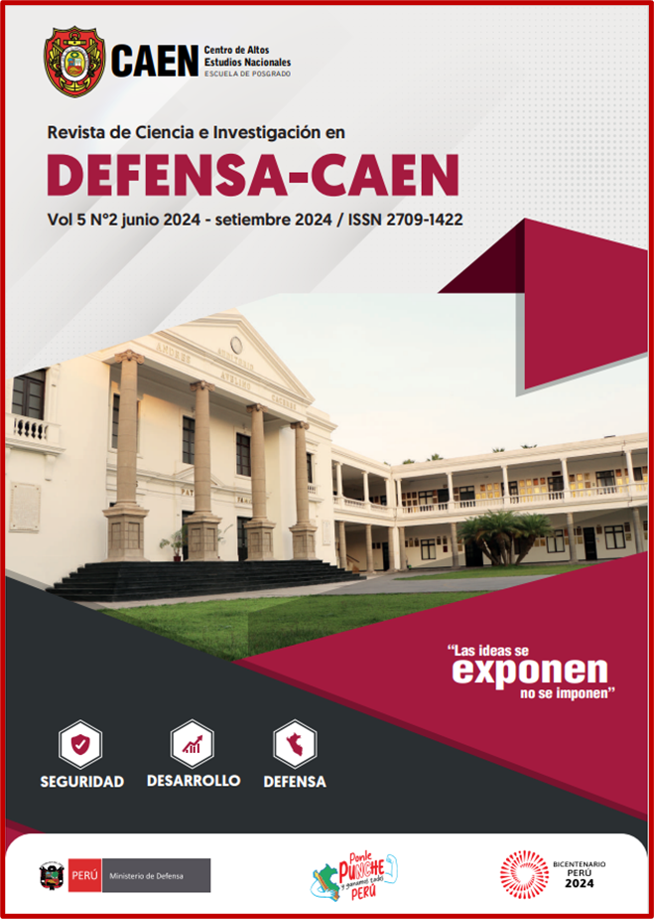Ecosistemas digitales de vigilancia e inteligencia global y su impacto en la Seguridad y Defensa Nacional
DOI:
https://doi.org/10.58211/6q7w0g73Palabras clave:
Seguridad y Defensa, Sistema de InteligenciaResumen
El presente articulo tuvo como objetivo identificar los ecosistemas digitales de vigilancia e inteligencia global y como estos impactan en la seguridad y defensa nacional, el desarrollo exponencial de la tecnología y la utilización del ciberespacio ha permitido que muchos gobiernos utilicen los sistemas de vigilancia global mediante inteligencia artificial y metadatos, al menos 77 países ya se encuentran usando sistemas públicos de reconocimiento facial, ciudades seguras con técnicas de vigilancia policial inteligente, actividades de inteligencia y contrainteligencia con el monitoreo masivo de las comunicaciones; este articulo busca determinar con exactitud qué es lo que causa el aumento de vigilancia y conocer las capacidades de estos sistemas. Para abordar el análisis de este problema, se utilizó un enfoque cualitativo mediante un método hermenéutico interpretativo de las categorías de estudio usando la técnica documental, el articulo analiza aspectos como la vigilancia e inteligencia global y la seguridad y defensa nacional; la conclusión más significativa de la presente investigación es que la vigilancia e inteligencia global impactan significativamente en la seguridad y defensa nacional de los países.
Referencias
Bigo, D. (2016). Digital Surveillance and Everyday Democracy. Leanne Weber; Elaine Fishwick; Marinella Marmo. The Routledge International Handbook of Criminology and Human Rights, Routledge,125 - 135, 2016.
Dencik, L., & Wahl-Jorgensen, K. 2017. Sociedad de Vigilancia y Ciudadanía Digital – Introducción Revista Internacional de Comunicación, 11, 731-739
Dulzaides Iglesias, M. E., & Molina Gómez, A. M. (2004). Análisis documental y de información: dos componentes de un mismo proceso. Acimed, 12(2), 1-21. http://scielo.sld.cu/pdf/aci/v12n2/aci11204.pdf
Feldstein, S. (2019). The global expansion of AI surveillance. Carnegieendowment. https://carnegieendowment.org/research/2019/09/the-global-expansion-of-aisurveillance?lang=en
Hernández-Mosqueda, J. S., Tobón-Tobón, S., & Vázquez-Antonio, J. M. (2014). Estudio conceptual de la docencia socioformativa. Ra Ximhai, 10(5), 12. http://www.redalyc.org/pdf/461/46132134006.pdf
Hernández, J. S., & Vizcarra, J. J. (2015). Didáctica para la formación integral en la sociedad del conocimiento. Horson ediciones. México. 2015
Hintz, A., Dencik, L., & Wahl-Jorgensen, K. (2017). Digital citizenship and surveillance| digital citizenship and surveillance society. International Journal of Communication, 11, 9.
Harding, L. (2015). The Snowden Files: The Inside Story of the World’s Most Wanted Man. National Geographic Books.
Hernández, J. S., & Vizcarra, J. J. (2015). Didáctica para la formación integral en la sociedad del conocimiento. Horson ediciones. México. 2015.
James, A. (2018). Vigilancia masiva gubernamental y ley en los países de los cinco ojos (Tesis doctoral, tesis doctoral).
Katz, R. 2015. El ecosistema y la economía digital en América Latina. Barcelona: Editorial Ariel; Fundación Telefónica; Editorial Planeta, p.12. http://scioteca.caf.com/handle/123456789/768
Leminen, S., Rajahonka, M., Westerlund, M. y Wendelin R. 2018. El futuro de Internet de las cosas: hacia ecosistemas heterárquicos y modelos de negocio de servicios. Revista de marketing industrial y empresarial. 33(6): 749-767. DOI: https://doi.org/10.1108/JBIM-10-2015-0206
Lu, M. (2023, 18 septiembre). Charted: The Exponential Growth in AI Computation. Visual capitalist. https://www.visualcapitalist.com/cp/charted-history-exponential-growth-in-aicomputation
Secretaría de Seguridad y Defensa Nacional - SEDENA (2015). Doctrina de Seguridad y Defensa Nacional. https://www.esup.edu.pe/wpcontent/uploads/2021/01/8.%20Doctrina%20de%20Seguridad%20y%20Defensa%20Nacional%202015.pdf
Schuster, S., Van Den Berg, M., Larrucea, X., Slewe, T., & Ide-Kostic, P. (2017). Mass surveillance and technological policy options: Improving security of private communications. Computer Standards & Interfaces, 50, 76-82. https://doi.org/10.1016/j.csi.2016.09.011
Tobón, S. (2015). Cartografía conceptual: estrategia para la formación y evaluación de conceptos y teorías. https://issuu.com/cife/docs/e-book__cartograf__a_conceptual
Tobón, S., Guzmán, C. E., Silvano Hernández, J., & Cardona, S. (2015). Sociedad del conocimiento: Estudio documental desde una perspectiva humanista y compleja. Paradigma, 36(2),7-36.
https://www.researchgate.net/profile/Sergio_Tobon4/publication/288671205_Sociedad_del _Conocimiento_Estudio_documental_desde_una_perspectiva_humanista_y_compleja/links/568319e508ae1e63f1f01395.pdf
Vivas Moreno, A., & Martos García, A. (2010). La cartografía conceptual y su utilidad para el estudio de la lectura como práctica histórico-cultural: El Quijote como ejemplo. Investigación bibliotecológica, 24(51), 95-124. http://www.scielo.org.mx/pdf/ib/v24n51/v24n51a5.pdf
Westerlund, M., Isabelle, DA, Leminen, S. (2021). La aceptación de la vigilancia digital en la era del big data. Revisión de la gestión de la innovación tecnológica, 11(3): 32-44. http://doi.org/10.22215/timreview/1427
Descargas
Publicado
Número
Sección
Licencia
Derechos de autor 2024 Luis Castro Gonzalez, Emilio Felipe Planas Woll

Esta obra está bajo una licencia internacional Creative Commons Atribución 4.0.
La Revista de Ciencia e Investigación en Defensa está afiliada a la Licencia Creative Commons CC Reconocimiento 4.0 (CC BY). Esta licencia permite a los reutilizadores distribuir, remezclar, adaptar y construir sobre el material en cualquier medio o formato, siempre que se le dé la atribución al creador. La licencia permite a los autores mantener sus derechos y hacer el uso comercial de sus artículos.








